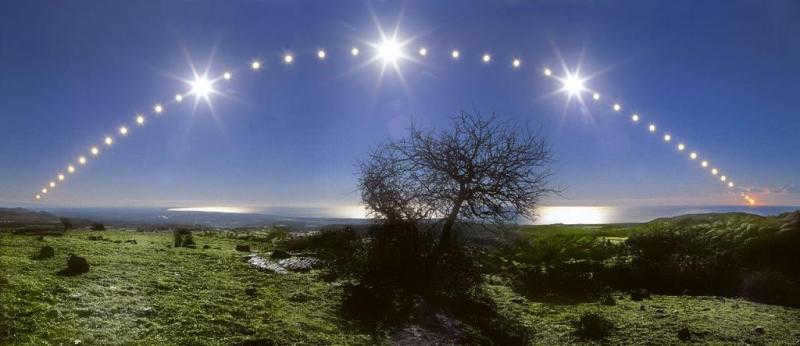
The amount of energy that our planet receives from the Sun is only a small portion of the total energy emitted by the star, but it is significantly greater than all the energy generated artificially on Earth.
The sun completes one revolution around its axis in approximately 25.4 of our regular twenty-four-hour days.
The estimated distance from our planet to the Sun is 149.5 million kilometers, but these values are so immense in terms of distance that they are measured in terms of the time it takes for light to travel. It takes sunlight 8 minutes and 18 seconds to reach Earth (traveling at a speed of 300,000 kilometers per second).
The constellation Lyra is where the entire solar system is continuously moving towards in the vastness of outer space. This movement occurs at a speed of 20 kilometers per second.
Could you explain what is meant by the term “zenith”?
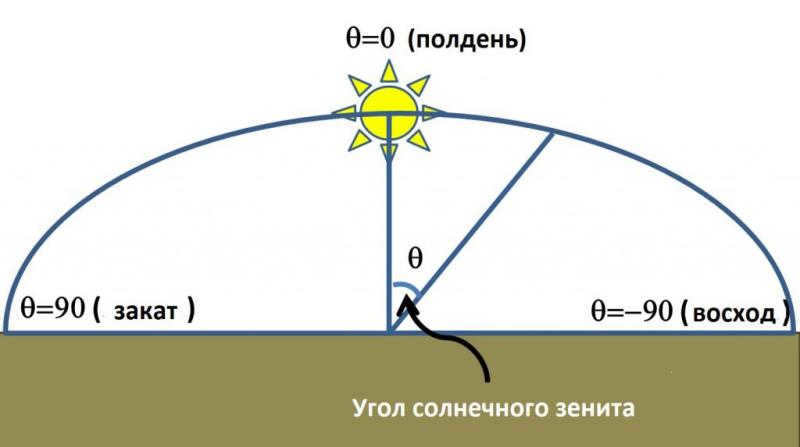
Nevertheless, in everyday language, the term “zenith” is often used to refer to the highest point of the sun’s position. However, it should be noted that the sun’s rays do not always fall at a 90-degree angle on all parts of the Earth, as this depends on the specific positions of celestial bodies in outer space.
Changes in the position of the sun’s zenith throughout the year
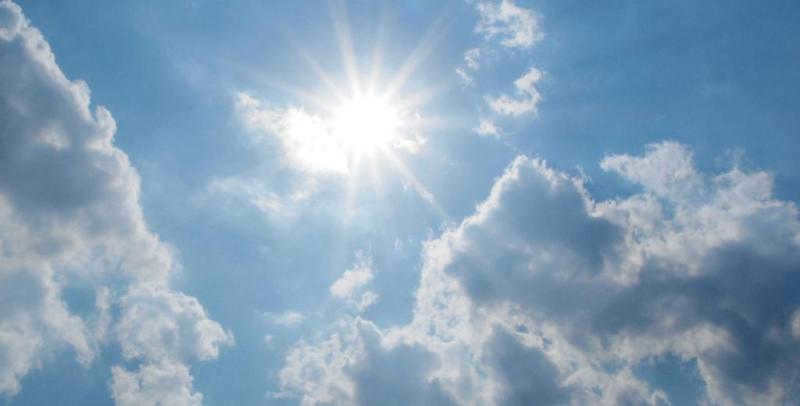
If you have a basic understanding of the solstice days, you can make a rough estimate of the latitude where the sun will be directly overhead on any given date.
Which locations on Earth experience the sun at its zenith?

Because of the Earth’s shape and its axis tilted 23 degrees towards the Sun, not every point on the planet can experience the position of the sun directly overhead, which is known as the zenith. This phenomenon is out of reach for the majority of people.
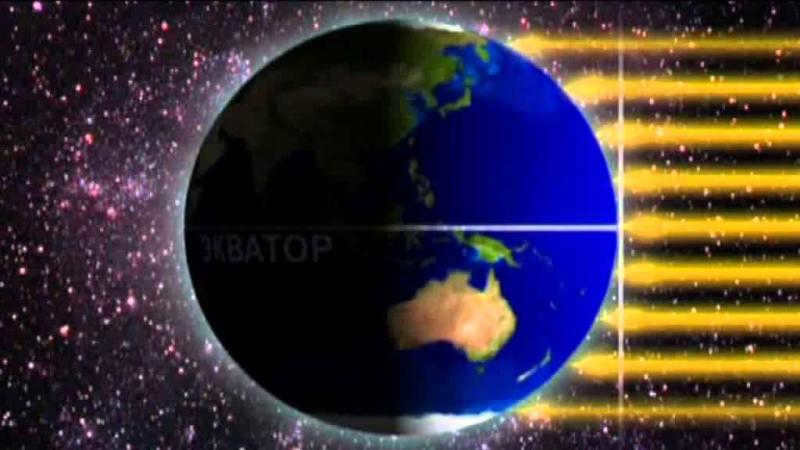
At noon, the sun’s zenith position is only possible within the Northern and Southern tropics, which are named after the constellations Cancer and Capricorn respectively.
Among them is a young poetess from Moscow, named Kira Tikhonova (formerly known as Danilyants), who won the Pushkin Youth Festival “On a par with the century”.
The sun is directly above, while my coat rests in the snow.
Snow, like in the tundra, a celebration for children!
We arrive home in darkness,
As hot as a sauna,
The sun is at its peak, shorts covered in dust.
Steering wheel tainted with red rust.
Knees, covered in green, knocked down once again.
The sun feels like the tropics, thirty-five degrees!
Ten years before the first computers.
Childhood, as joyful as light,
The sun at its zenith. Wearing overalls.
My oldest child, with a furrowed brow,
Kicking the snow with a delicate toe
And an aspiring author from the town of Mytishchi in the Moscow Region, Victoria Vikolskaya.
When the sun reaches its highest point
And when the evening comes, the sun reaches its highest point in the sky.
This happens not only at noon, but also in the evening.
Even if the weather is cloudy, the sun still reaches its zenith!
That’s how it is today, and that’s how it was yesterday.
What’s so remarkable about it is that the sun doesn’t care.
When the sun is at its zenith, there isn’t a single cloud in the sky.
A beam of sunlight shines on a glass.
A beam of sunlight illuminates a leaf on a tree.
That ray of sunshine shines brightly.
Even if there’s just one ray, no matter how faint it may be,
It’s stronger than the clouds!
Because it managed to break through the clouds,
♪ Given by the powerful sun ♪
If that ray managed to break through the clouds, –
It’s not a cloudy day anymore,
If there’s a single ray,
Then the sun is at its zenith!
While it may not be scientifically accurate, the weather is incredibly pleasant and sunny.
The symbolism of the sun at its highest point

The sun holds a prominent position in various symbolic doctrines. When it comes to its significance as a symbol that affects the interpretation of dreams, there are diverse explanations found in various compilations.
vladivostok
Vladivostok
Is it possible for the power to alter the Earth’s rotation speed?
At what time does the sun reach its zenith? At noon? At 13:00? At 14:00? A little bit of literacy for members of parliament, journalists, and bloggers.
Meanwhile, in my view, Kalashnikov’s proposal is one of the few sensible bills recently introduced in the State Duma. Its only drawback is that it lacks conviction and completeness. The direction is correct, but it needs further refinement.
However, we must first grasp the concept of time zones and understand the commotion surrounding it. Because
1) The Earth completes a full rotation on its axis in a span of 24 hours.
4) During the year 1930, the Bolsheviks enforced a unique “decree time” for the USSR, which differed by one hour from the local time. This decree eliminated the switch from summer time to winter time. As a result, starting from 1930, the sun would reach its highest point in the sky at 13:00 throughout the year, regardless of whether it was winter or summer.
5) In 1981, the USSR reinstated the transition to summer time and designated the “decree time” as the “winter time”. Consequently, during winter, the sun would be at its zenith at 13:00, while during summer, it would reach its highest point at 14:00.
6) In a significant move last year, President Medvedev abolished the switch between winter and summer time, opting to keep summer time as the standard. As a result, our local time now differs from the natural, biological clock by 2 hours. When it’s 6 a.m. according to the natural calendar in our region, our clocks display 8 a.m., indicating that it’s time to wake up. This change has resulted in a multitude of complaints from various groups of citizens experiencing chronic sleep deprivation.
Now Kalashnikov is proposing a solution to this issue. Instead of a two-hour advance schedule, he suggests changing it to one hour. This is a positive step, but it would be more effective to make decisive and final decisions, rather than half-hearted ones, in order to avoid yearly back-and-forth adjustments.
If I were a member of the State Duma, I would vote in favor of the following plan:
1) Move the clocks back by 2 hours, aligning with the natural local time where the sun is at its zenith at noon.
2) Eliminate the transition between winter and summer time as humans have no control over the sun, and noon will always be noon regardless of any mandates.
3) However, considering that the sun rises earlier in the summer and later in the winter, it should be mandatory for state and budgetary institutions to adjust their working hours between winter and summer time. For example, in the summer, some institutions could work from 9 am to 6 pm, while in the winter, they could work from 10 am to 7 pm, and so on. Interestingly, this principle was followed in the Russian Empire, where the work schedule of state offices changed on the last Sunday of March and September, rather than adjusting the clocks. This approach was much more logical.
4) Once this adjustment is made, there should be no more changes to the time. That’s it. We will stick to the natural time and put an end to any further experimentation.
Regrettably, I do not hold a position in the State Duma, hence I cannot ascertain if my suggestions will be taken into consideration. Nonetheless, I remain optimistic that, in this instance at least, rationality will prevail. This matter should not be viewed through a political lens. The paramount concern is that the opposition refrains from exploiting it, as otherwise, the deputies might deliberately impose such conditions upon us that will lead to widespread suffering.
Lesson plan
Lesson 06. Sunlight on Earth.
List of questions covered during the lesson
Equinox, Solstice, Tropics, Polar Circles, Zenith, Polar Day, Polar Night, Sunrise, Sunset.
Equinox – Occasions when the duration of day and night are equal.
Solstice – The times when the duration of day and night are at their shortest or longest.
The alternation of day and night – is a result of the Earth’s rotational motion.
Tropics – Imaginary lines that mark the area on either side of the equator within which the Sun is directly overhead.
Polar circles – Imaginary lines that mark the area around the poles where there are periods of polar day and polar night.
Zenith – The highest point of the Sun’s path above the horizon.
Required and additional resources on the topic
Study materials for self-study
Living without light is extremely challenging and likely impossible. Light serves as the primary source of life for humans, plants, and animals. It enables us to navigate our surroundings, perceive our environment, and appreciate the beauty of the world.
Today’s lesson focuses on the topic of Sunlight on Earth.
During our lesson, we discovered that Planet Earth is a component of the solar system. It undergoes both rotation around its own axis and revolution around the sun. The Earth’s rotation is responsible for: a) its shape; b) the alternating periods of day and night. Due to the Earth’s orbital motion and the constant tilt of its axis in relation to the plane of its orbit, our planet receives uneven sunlight throughout the year, resulting in the changing of seasons. When the Sun never dips below the horizon, the phenomenon known as polar day occurs, extending from the polar circle to the pole. Conversely, when the Sun remains hidden behind the horizon, polar night takes place, spanning from the polar circle to the pole. On maps and globes, the polar circles are imaginary lines that mark the latitudes above which these phenomena occur.
Analysis of a typical training task:
Task type: Establish connections between elements of two sets;
Question text: Match a definition with a concept.
The time period when the Sun does not go below the horizon in the polar regions of the north and south.
The time period when the Sun does not rise above the horizon in the polar regions of the north and south.
Correct answer:
The time period when the Sun does not rise above the horizon in the polar regions of the north and south.
The time period when the Sun does not rise above the horizon in the polar zones of the north and south.
Analysis of a typical test task
Task type: Choose an item from the dropdown menu.
Question text: In the Southern Hemisphere, which river bank is steeper due to the Earth’s axial rotation?
Correct option(s) (or correct combinations of options):
What are the three specific time intervals during which namaz cannot be performed?

There are three specific time intervals during which it is not permissible to perform namaz. I have recently become aware of this and I have a good understanding of when the sun is at its zenith. However, I would appreciate it if you could explain when exactly sunrise and sunset occur, as well as the approximate duration of each.
From this hadith, one can conclude the following ruling:
The reason for discouraging performing prayers after the morning prayer and after the afternoon prayer is to avoid resembling those who worship the sun, as they perform their worship at that specific time. As for the reason why it is discouraged to perform the midday prayer when the sun is at its highest point, it is because, according to some narrations, it is at this time that the fire in Hell is ignited (Muslim, Salatul-Musafirin).
Discovering the Meaning of “The Sun is at its Zenith”
When we find ourselves sweating on a scorching summer day, with the clear sky above us, we often hear the phrase “the sun is at its zenith”. Our interpretation of this expression is that the sun is at its highest point, radiating intense heat onto the earth’s surface. To gain a deeper understanding of this statement, let’s explore some basic astronomy and examine the accuracy of our interpretation.
Parallels of the Earth
The Equator
The Tropics
The Earth has two sets of Tropics, one in the Southern Hemisphere and one in the Northern Hemisphere. Interestingly, the sun reaches its highest point in the sky here only once a year, which happens during the solstice. During the winter solstice on December 22, the Southern Hemisphere is tilted towards the Sun the most, while on June 22, it is the Northern Hemisphere that is tilted towards the Sun the most.
Sometimes, the Tropics in the Southern and Northern Hemispheres are named after the zodiacal constellation that lies along the path of the Sun during these times. For instance, the Tropic of Capricorn is used to refer to the Southern Tropic, which occurs in December, while the Tropic of Cancer is used to refer to the Northern Tropic, which occurs in June.
Polar Circles
The polar circle is the latitude above which the phenomenon of polar night or day can be witnessed. The positioning of the polar circles also has a precise mathematical explanation – it is 90° minus the tilt of the Earth’s axis. In the case of our planet, the value of the polar circles is 66.5°. Sadly, individuals living in temperate latitudes are unable to experience these phenomena. However, for those on the parallel corresponding to the polar circle, the sight of the sun at its zenith is a completely natural occurrence.
The Earth is in constant motion, both revolving around the Sun and rotating on its axis every 24 hours. Over the course of a year, we witness the shifting length of the day, the fluctuating temperature, and for the keen observer, the changing position of the stars in the sky. In a span of 364 days, the Earth completes an entire orbit around the Sun.
Day and Night
When darkness falls and night arrives, it signifies that the Sun is currently illuminating the other hemisphere. This raises a logical question: why is the length of the day not equal to the length of the night? The answer lies in the fact that the plane of the Sun’s trajectory is not perpendicular to the Earth’s axis. If it were, we wouldn’t experience seasons, where the ratio of daylight to nighttime changes.
Interestingly, this cycle repeats itself in reverse order until the Sun reaches its zenith on the equatorial line at noon on September 23. This marks the arrival of midsummer in the southern hemisphere.
Although we have analyzed the correct explanation of the concept of “the sun at the zenith”, we are more familiar with the wording that simply implies the sun being at its highest point on this particular day.
There are several belts on the globe that are distinguished by the degree of illumination – one tropical, one temperate, and one polar in each the northern and southern hemispheres.
In total, there are five belts of illumination:
Tropic of light
The tropical light belt is defined by the Southern and Northern Tropics, which are located at 23.44 ° south latitude and 23.44 ° north latitude respectively. Within this belt, sunlight shines directly onto the Earth’s surface, creating a right angle of incidence. This means that the Sun is directly overhead, causing objects and structures to cast no shadow. The terrain within this region receives the highest amount of solar heat and light. This phenomenon is most pronounced during the winter solstice in the southern tropics and the summer solstice in the northern tropics.
Further north and south of the tropical light belt, there are the temperate light belts. These zones are characterized by an average level of illumination that varies depending on the Earth’s position in its annual orbit around the Sun. During winter, the incoming light from the Sun is at one level, while during summer it is at another level. As a result, the amount of heat received by the Earth’s surface differs. In the temperate light belts, the Sun never reaches the zenith position throughout the year. In the Northern Hemisphere, the boundaries of the temperate illumination belt are at the latitude of the Northern Tropic (23.44°) and the latitude of the Arctic Circle (66.56°). In the Southern Hemisphere, the boundaries are the Southern Tropic and the Arctic Circle, with corresponding coordinates on the parallels.
Illuminance Polar Circles
The polar circles, located at 66.56° north and south latitudes, mark the boundaries of the polar belts of illuminance in both hemispheres. These regions experience minimal illumination on the Earth’s surface. The polar illumination belt is determined by the latitude at which the Sun reaches its highest point above the horizon during the December solstice, which is 66.56° north. Similarly, in the southern hemisphere, the solar disk is only visible at its highest point in June during the solstice, at 66.56° south latitude.
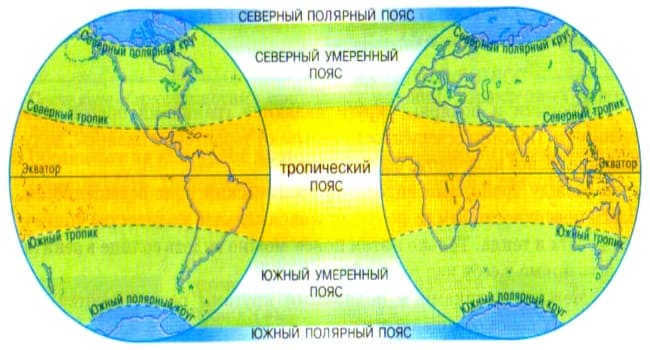
Boundary of Brightness Belts
During the polar day at the poles, the sun is positioned closer to the horizon and does not reach a high point in the sky. As a result of the shallow angle of incidence, the sun’s rays warm the surface slightly, mainly reflecting off snow-covered plains and icy mountain cliffs. Conversely, during polar night, the sun remains below the horizon. In these latitudes, there can be temperature differences ranging from 35°C to 65°C. The climate in these regions is determined by the extent to which the Earth’s surface is heated, in other words, how effectively the Sun illuminates this particular part of the Earth.
The existence of the boundaries of illumination belts is determined by the division of zones based on the amount of incoming sunlight between each other.
What exactly defines the limits of lightness belts? These are commonly recognized parallels that divide the areas of the planet that are illuminated – the Tropic of Cancer and the Tropic of Capricorn, the Arctic Circle and the Antarctic Circle. Refer to Figure 2.
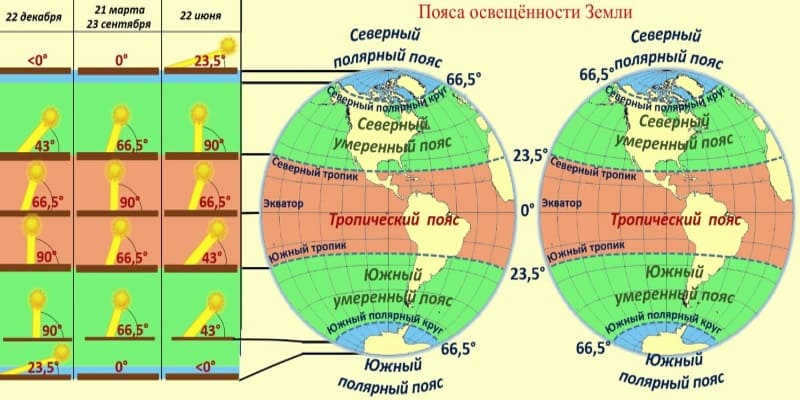

Impact of Illumination Zones on Climate Formation
The sun serves as a heat source, radiating warmth onto the Earth’s surface and the surrounding atmosphere. As sunlight, which carries heat energy, reaches the planet’s surface at varying angles in different latitudes, it results in an uneven distribution of heat absorption by the surface.
For instance, in equatorial latitudes, sunlight strikes the surface at a 90° angle, resulting in maximum heat absorption, while in northern latitudes, the angle of incidence is 30°, leading to comparatively lower heat absorption in these regions of the planet.
It should be noted from the beginning that the boundaries of heat belts and lightness zones on Earth are distinct and not the same. Heat belts are mainly influenced by factors such as the formation of mountains, the proximity of coastal areas where seas and oceans meet continents, the varying directions of ocean currents, and the distribution of air currents and precipitation.
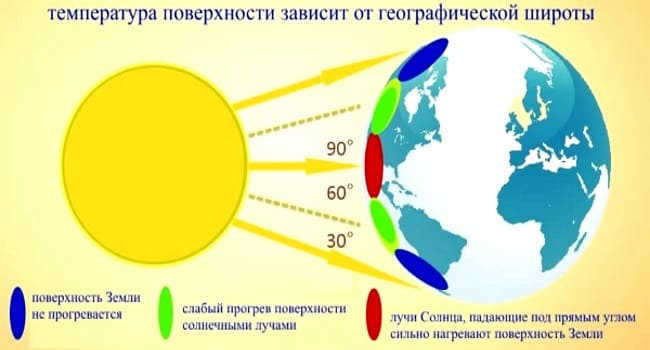

Why is there less variation in surface and air mass temperatures at the equator compared to northern latitudes? This is due to the slight changes in the angle of sunlight throughout the year.
Based on the findings mentioned above, there are distinct boundaries between the lightness belts. These boundaries are the parallels at 23.44° and 66.56° of northern and southern latitudes. These lines are also known as the Northern and Southern Tropics, the Arctic Circle, and the South Polar Circle. These four parallels are prominently marked on the map.
Working hours: 10:00 am to 9:00 pm,
Closed on Tuesdays.
The “Retro Café” operates from 10:00 am to 8:00 pm on the days when the Planetarium is open.
Contact number: +7 (495) 221-76-90
Planetarium JSC © 2017. Moscow, Sadovaya-Kudrinskaya str. 5, pp. 1
June 21 marks the arrival of the summer solstice
The longest day of sunlight in the year and the shortest night in the Northern Hemisphere of the Earth.
On June 21, 2023 at 17:57 Moscow time, we will witness the occurrence of the summer solstice. At this specific moment, the Sun will reach its farthest position from the celestial equator towards the North Pole of the World, while moving along the ecliptic.
For the Northern Hemisphere of the planet, it will mark the beginning of astronomical summer, while in the Southern Hemisphere, winter will commence.
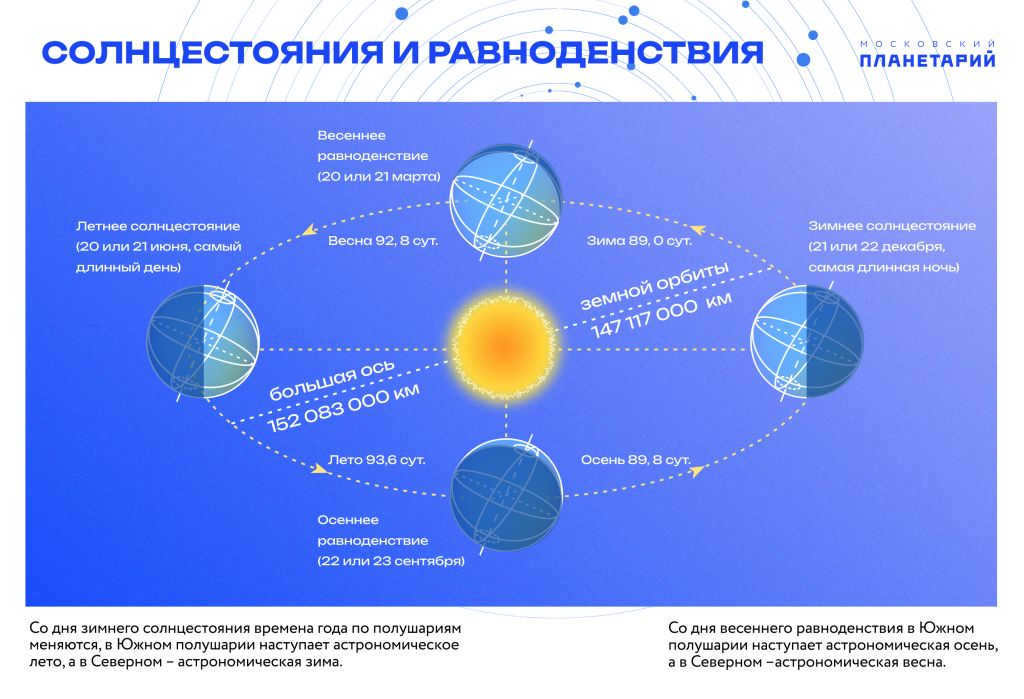
Therefore, in the Northern hemisphere, the day with the most daylight and the shortest night is observed. This occurrence is due to the fact that during the summer solstice, the Sun rises in the northeast, reaches its highest point above the horizon in the south, which means that at noon, the Northern Hemisphere experiences the highest position of the Sun, and then sets in the northwest. The Sun remains above the horizon for the majority of the day, making June 21 the longest day of the year and providing the most daylight hours in the Northern Hemisphere. In cities like Moscow, the longest day lasts for approximately 17 hours and 33 minutes. To compare, on the day of the winter solstice, which falls on December 21, the duration of daylight in Moscow is only 7 hours.
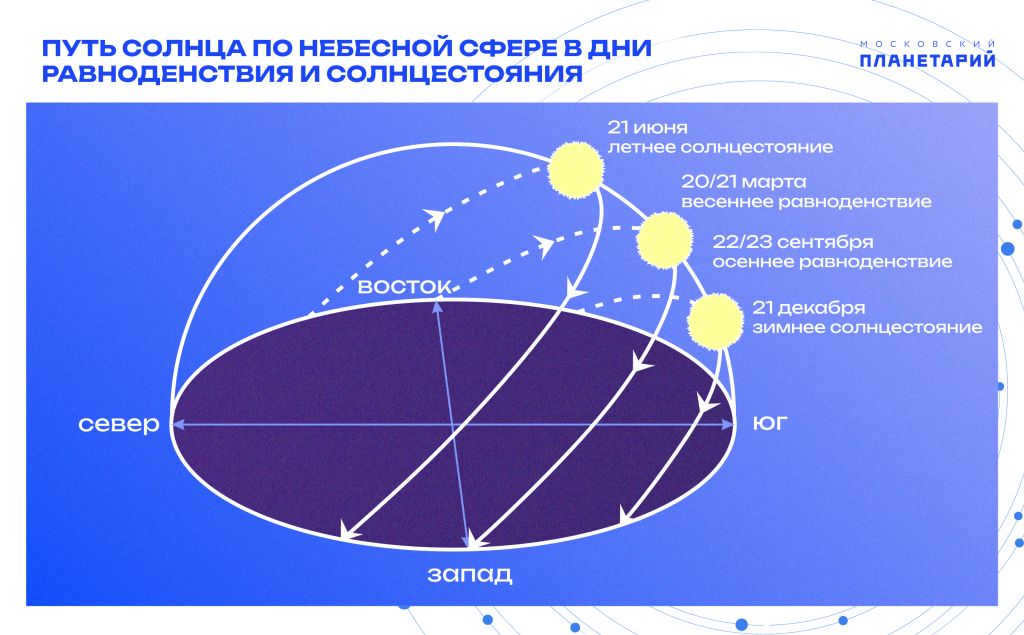

On June 21, at the latitude of Moscow, the Sun reaches a peak altitude of over 57 degrees (57.6 0 ). During the days surrounding the solstice, the Sun remains at this high position, almost as if it pauses for a while. This is why these days are called solstices. Afterward, the Sun starts to gradually descend towards the south, bringing its midday height closer to the horizon and causing the daylight hours to shorten. On the winter solstice, which falls on December 21, the Sun’s height above the Moscow horizon will not exceed 11 degrees (10.8 0 0 ).
Therefore, on June 21, 2023, the day of the summer solstice, we will witness the Sun at its highest point above the Moscow horizon during astronomical noon (13:30 Moscow time)!
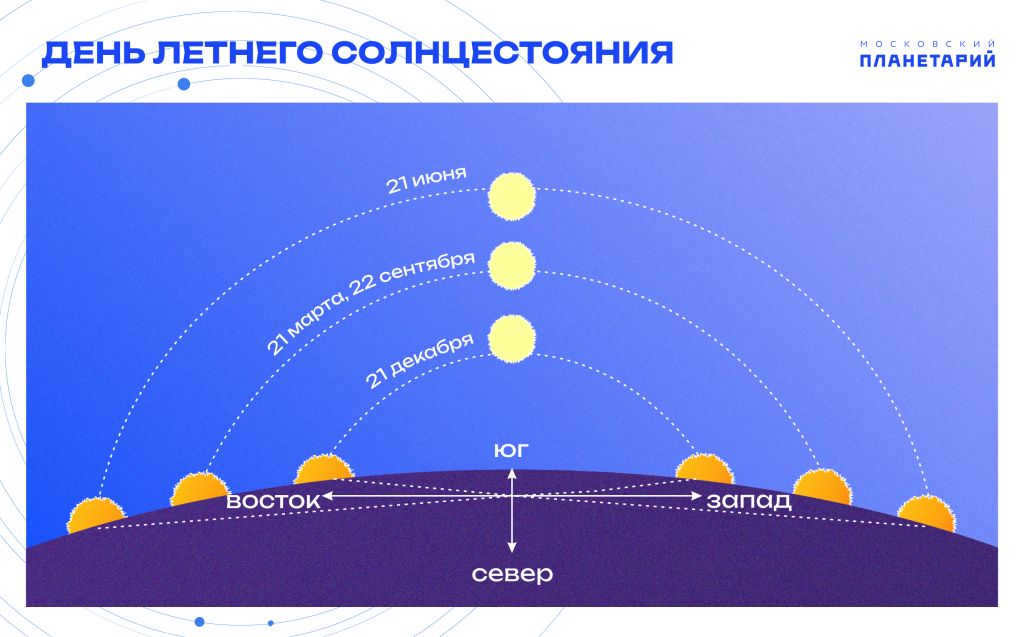
According to the picture, the Sun’s elevation at midday varies on the solstice and equinox, with the highest Sun at midday occurring during the summer solstice.
From June 22 onwards, the Sun’s path shifts from the Taurus constellation to the Gemini constellation.
Midnight Sun and Polar Day.
In St. Petersburg, the phenomenon known as the white nights occurs, while north of latitude 66 experiences the remarkable phenomenon of polar day. During polar day, the sun remains above the horizon throughout the entire day, creating a unique celestial spectacle.

Therefore, in Murmansk, situated at a latitude of 68 o 58', right in the heart of the polar day, which spans over 2 months from May 22nd to July 22nd, the Sun remains above the horizon line throughout this entire period.
For countless centuries, the summer solstice held immense significance for all cultures that lived in harmony with the natural rhythms and structured their lives accordingly. Many temple structures were precisely aligned to capture the sunrise on the day of the summer solstice. This celestial event infuses the entire natural world with potent solar energy, nourishing and empowering all living beings on Earth.
We extend our warmest congratulations to you on the commencement of astronomical summer, on the day when the Sun reaches its highest point in the sky, on this day of the summer solstice!
Every morning, the gentle sun beckons us to wake up and embark on new adventures in this magnificent world. And as the day comes to a close, the sun slowly makes its way across the sky, bidding us farewell as it sets behind the horizon, offering us a well-deserved respite after a long day of work. But where does this journey begin? And where does the sun go at the end of its voyage?
The sun’s ascent starts in the east, illuminating the world with its warmth and light. At the end of the day, it bids us adieu in the west, continuing its journey on the other side of our awe-inspiring planet. And come morning, it rises once again in the east, bringing forth a new day. This is the perspective we witness from Earth. However, it is fascinating to note that ancient civilizations held a different belief about this phenomenon. So, where does the sun truly vanish, and how does it reemerge in the sky?
If we don’t delve into the specifics of the ancient people’s perspective, we can acknowledge their correctness. The reality is that our planet is a component of the solar system, with the Sun being stationary and positioned at the center. In contrast, the Earth revolves around the Sun in its own orbit and, in addition to this movement, rotates on its imaginary axis. The planet completes a full rotation in 24 hours, or in other words, within a day. This is why it appears to us that the locations where the sun sets and rises remain constant.


A perspective from outer space
If we were able to observe the Solar System from a distant vantage point in space (allowing us to view all of the planets), the scene would unfold as follows: all of the celestial bodies within this system orbit in the same direction, from west to east (counterclockwise). However, Venus stands out as it rotates on its axis in the opposite direction compared to the other planets. Astronomers have theorized that this anomaly is the result of a powerful asteroid collision that occurred many years ago, disrupting its rotational pattern. Similarly, Uranus appears to be “upside down” due to similar forces. Observing it now, one would witness a sideways view of its rotation.
If an individual were to observe the motion of the primary celestial body from the Arctic, they would witness the anticlockwise revolution of the planet, as well as the location where the sun descends and ascends. From a visual standpoint, the movement of the heavenly object would appear to be from west to east. In actuality, it would move in an eastward direction while the Earth revolves on its axis.
Interestingly, the sunrise does not occur simultaneously in various regions of the globe. For instance, on the eastern coast of the United States, it transpires three hours before those areas on the western coast. Consequently, the sunset also transpires at different times in diverse regions of the world.
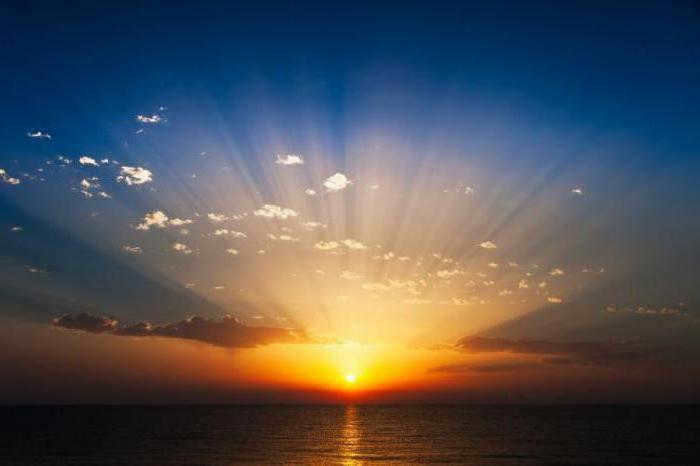
The Beauty of Twilight
The period of time just before sunrise and just before sunset is known as twilight. It is a truly magnificent sight to behold. The sun’s disk is positioned very close to the horizon, allowing some of its rays to penetrate the upper layers of the atmosphere and reflect off the Earth’s surface. This creates a mesmerizing display of colors that lasts for approximately 2 hours, although the duration may vary based on the latitude. In polar regions, twilight can last for several hours before sunset, and in the extreme polar regions, it can endure for 2 to 3 weeks! On the other hand, at the equator, twilight before sunrise only lasts for 20-25 minutes.
Currently, due to the phenomenon of light refraction, we are able to witness a breathtaking spectacle as the sun’s beams cast a kaleidoscope of hues on the Earth’s surface and the sky.

Distinctive Features of Sunrise and Sunset
The Earth ceaselessly orbits around the Sun and spins on its axis, and once in every 24 hours (except in polar regions), the solar disk emerges and vanishes beyond the horizon, signifying the commencement and conclusion of the daytime period. Consequently, in the field of astronomy, sunrise and sunset denote the moments when the uppermost point of the solar disk becomes visible or disappears beyond the horizon.

Secrets of the Bermuda Triangle229514.3993
When the sun’s rays shine on the Earth’s surface and the sky during sunrise and sunset, a fascinating optical effect occurs, resulting in a beautiful display of colors. In the early morning, before sunrise, the colors appear more delicate, while during sunset, the planet is bathed in vibrant shades of red, maroon, yellow, orange, and occasionally even green.
The intensity of the sunset colors can be attributed to the warming of the Earth’s surface during the day, which leads to a decrease in humidity, an increase in air flow, and the suspension of dust particles in the air. The variation in colors observed between sunrise and sunset largely depends on the specific location from which one observes these captivating natural phenomena.
Orienteering: How to Find Cardinal Directions Without a Compass?
If you have a wristwatch with analog hands, you can determine the cardinal directions without a compass. Hold the watch horizontally and rotate it clockwise until the hour hand points towards the sun. Then, imagine a line that bisects the number 12 on the watch and the direction of the sun. This line represents the north-south axis. It’s worth noting that before noon, the south direction is to the right of the sun.
Knowing how to find cardinal directions without a compass is crucial for orienteering in any location. This skill is especially valuable for tourists, forestry workers, hunters, sailors, and other outdoor enthusiasts.
The approach outlined above can provide fairly accurate outcomes in higher latitudes. However, it only yields partial results in mid-latitudes, particularly during the winter season. In southern areas, where the sun sits high in the sky during the summer, inaccuracies may arise. Additionally, one must take into account the impact of daylight saving time on the determination of noon.
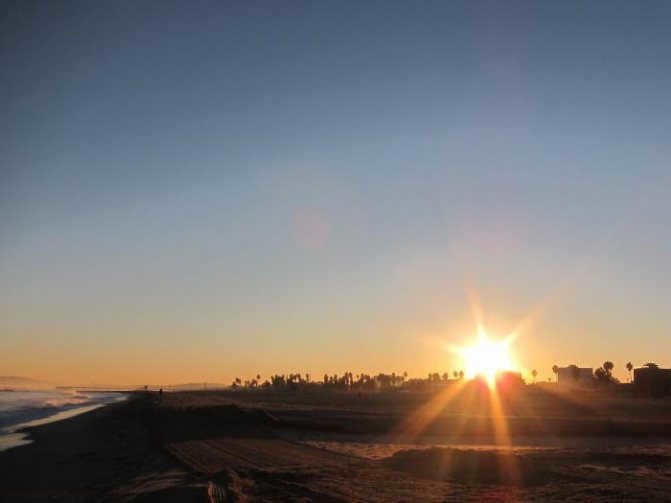
It is also important to keep in mind the directions of sunrise and sunset in regions with moderate latitudes. In these areas, the primary celestial body rises in the northeast during the summer and sets in the northwest. During the winter, it rises in the southeast and sets in the southwest. Only twice a year does the sunrise occur directly in the east and the sunset in the west. These occurrences happen during the equinoxes on March 21 and September 23.
It is widely believed that the Sun rises in the east and sets in the west. This phenomenon occurs only twice a year, specifically during the equinoxes which fall around March 21 and September 23.
During the summer, when the day is longer than the night, the positions of sunrise and sunset shift towards the north. Conversely, in winter, they shift towards the southern part of the horizon. The further north a location is, the greater the shift of the sunrise and sunset points from east to west.
Below is a table that illustrates the specific points on the horizon where the Sun rises and sets at various latitudes throughout the year. The angles (azimuths) are measured in degrees from a northern point.
| Time of year (months) | Latitude of the place | |||||||||||
| How many degrees from the point north the Sun rises and sets | ||||||||||||
| 42° | 44° | 46° | 48° | 50° | 52° | 54° | 56° | 58° | 60° | 62° | 64° | |
| December 22 | 122 | 124 | 126 | 127 | 128 | 130 | 133 | 136 | 139 | 143 | 148 | 155 |
| January 5 and December 5 | 121 | 122 | 124 | 125 | 127 | 129 | 131 | 134 | 137 | 141 | 145 | 152 |
| January 20 and November 20 | 118 | 119 | 120 | 121 | 122 | 124 | 126 | 128 | 131 | 134 | 137 | 142 |
| February 5 and November 5 | 112 | 113 | 114 | 115 | 116 | 118 | 119 | 121 | 123 | 125 | 127 | 131 |
| February 20 and October 20 | 106 | 106 | 107 | 107 | 108 | 109 | 110 | 111 | 112 | 114 | 115 | 117 |
| March 5 and October 5 | 98 | 98 | 98 | 99 | 99 | 99 | 100 | 100 | 101 | 102 | 102 | 103 |
| March 21 and September 23 | 90 | 90 | 90 | 90 | 90 | 90 | 90 | 90 | 90 | 90 | 90 | 90 |
| April 5 and September 5 | 82 | 82 | 82 | 81 | 81 | 81 | 80 | 80 | 79 | 78 | 78 | 77 |
| April 20 and August 20 | 74 | 74 | 73 | 73 | 72 | 71 | 70 | 69 | 68 | 65 | 65 | 63 |
| May 5 and August 5 | 68 | 67 | 66 | 65 | 64 | 62 | 61 | 59 | 57 | 55 | 53 | 49 |
| May 20 and July 20 | 62 | 61 | 60 | 59 | 58 | 56 | 54 | 52 | 49 | 46 | 43 | 38 |
| June 5 and July 5 | 59 | 58 | 56 | 55 | 53 | 51 | 49 | 46 | 43 | 39 | 35 | 28 |
| June 22 | 58 | 56 | 55 | 53 | 52 | 50 | 47 | 44 | 41 | 37 | 32 | 25 |
The data presented in the table challenges the widely held belief that the sun rises in the east and sets in the west.
Let’s examine this using the example of Leningrad, which is located at a northern latitude of 60°. On December 22, the sun rises in Leningrad at an azimuth of 143° from a point north (or 53° from a point east) towards the south. Around January 20 and November 20, the sun in Leningrad rises almost exactly in the southeast (at 134° from north), while on May 20 and July 20, it rises in the northeast. These figures indicate that the sun in Leningrad deviates by the same number of degrees from the north at sunset.
If we compare the positions of sunrise and sunset on the shortest and longest days in Leningrad, we find that the difference in the horizon (or azimuth) between the points of sunrise in Leningrad in winter and summer amounts to 106°.
Without aiming for precise accuracy, we can utilize the subsequent rough guideline: during the summer, the Sun ascends in the northeast and descends in the northwest, while during the winter, the Sun ascends in the southeast and descends in the southwest.
By employing the aforementioned chart, one can ascertain the countries on the horizon with greater precision by considering both the season and the latitude of a particular location (refer to the chart).
Using Shadow and Celestial Luminaries for Orienteering
One interesting technique for orienteering involves using shadows. When navigating in unfamiliar areas, it’s important to consider various celestial bodies to assist you in this task. During the day, the sun can be used as a reference point, while at night, the polar star can guide you.
By determining the direction in which the sun sets, you can also determine the other cardinal directions and choose the correct path. For instance, in regions located in the northern latitudes, during summer nights, the sun sets closer to the horizon. As a result, the northern sky appears brighter compared to the southern sky.

We know that when the sun is at its highest point, the shadow it casts is the shortest. This happens at noon. The direction of this shadow indicates the north. The same applies to the moon: when it is full and at its highest point above the horizon, it is in the south. This is when there is enough light to see shadows clearly. Similarly, during a full moon, the shadow is the shortest. This occurs at midnight. The direction of this shadow will indicate the north.
Initial visit to the antenatal clinic
During the initial appointment, the gynecologist obtains information about the pregnant woman’s well-being, inquires about past illnesses and surgeries, chronic conditions, previous pregnancies and deliveries, and occupational risks. Additionally, the doctor inquires about the health of the baby’s father and close relatives.
Subsequently, a physical examination of the pregnant woman is conducted on the examination table, during which the doctor measures the dimensions of the pelvis using a tazometer and a measuring tape.
The following step involves an evaluation on the gynecological chair, which permits the assessment of the uterus size in relation to the expected pregnancy term, its excitability, as well as the condition of the cervix and its appendages. Additionally, the internal dimensions of the pelvis are also assessed during the chair examination. It is mandatory to obtain a vaginal smear for flora analysis.
Upon completion of the examination, the obstetrician-gynecologist provides a conclusion regarding the presence of risk factors and formulates a plan for pregnancy management, offering the expectant mother recommendations on daily routine and a balanced diet. Vitamins are prescribed, and if necessary, medications are prescribed as well. The pregnant woman is provided with referrals for further examinations.





